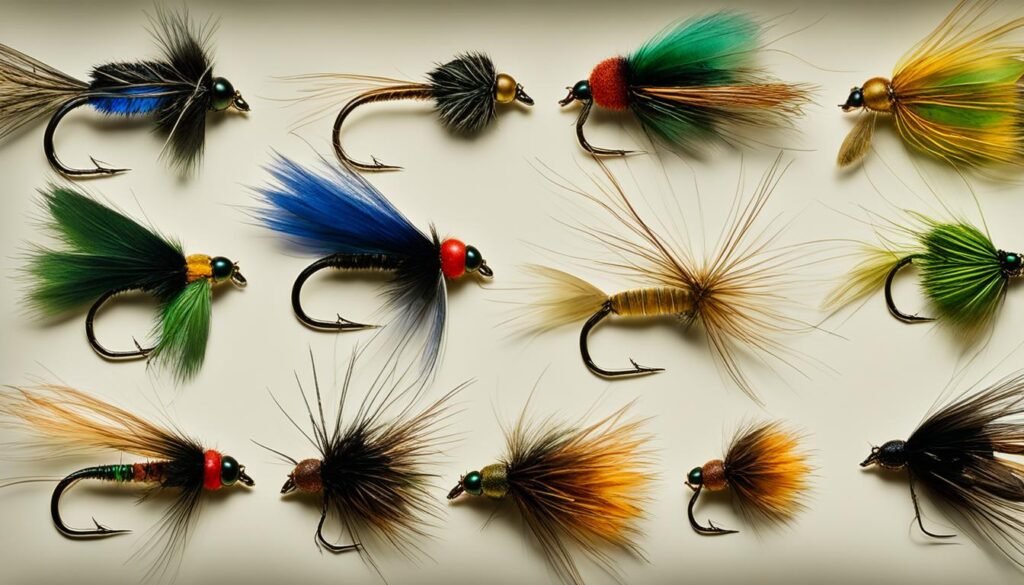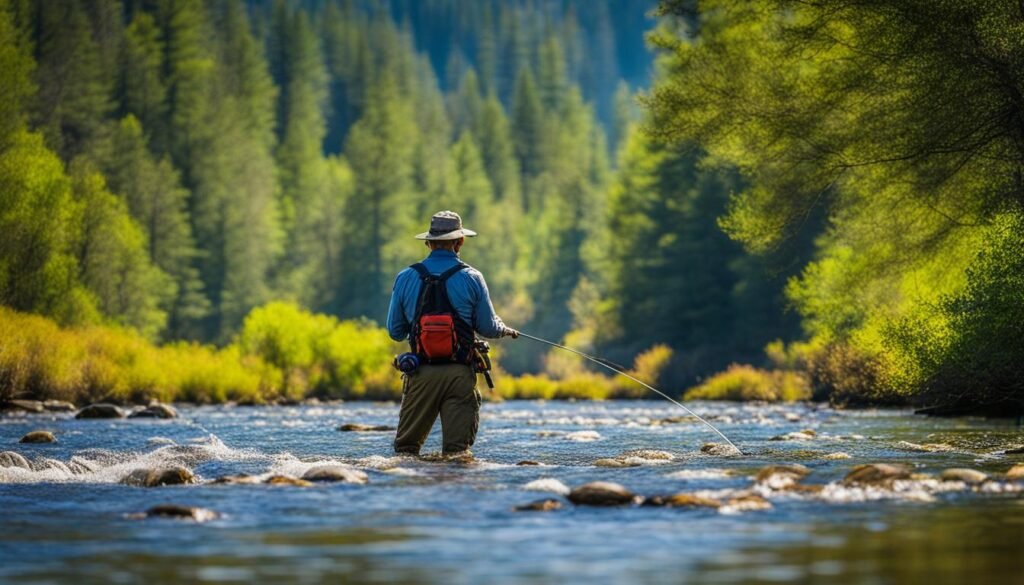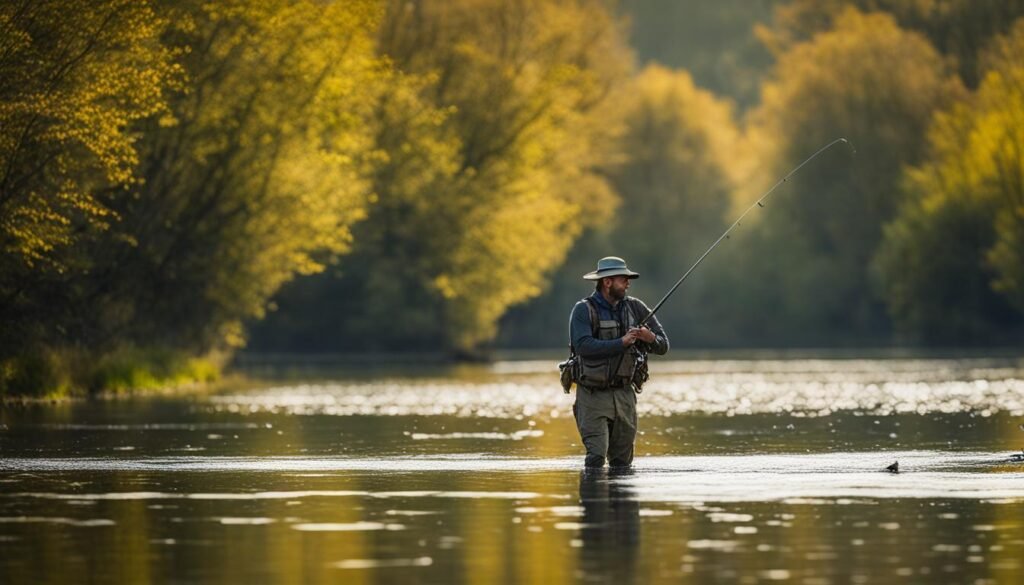Welcome to our beginner’s guide to understanding fly fishing flies. If you’re new to the world of fly fishing, navigating through the vast selection of flies can be overwhelming. But fear not, we’re here to help you make sense of it all. In this guide, we’ll provide you with a comprehensive overview of different fly fishing flies and the basics of fly selection. By the end, you’ll have a better understanding of the essential flies every angler should have in their fly box, empowering you to make informed decisions for your fishing adventures.
The Importance of Fly Selection in Fly Fishing
Fly selection plays a crucial role in the success of your fly fishing adventures. Choosing the right fly can make all the difference between a successful day on the water and frustration. Understanding the importance of fly selection and its impact on your angling experience is key to becoming a skilled fly angler.
When it comes to fly fishing flies, different insects and their life stages are imitated by specific fly patterns. The ability to identify and imitate the insects present in the water is essential for successful fly selection. By matching the hatch and choosing flies that resemble the natural insects, you significantly increase your chances of attracting fish and getting bites.
To effectively select the right flies, it is crucial to understand the life cycles of aquatic insects such as mayflies, caddisflies, and stoneflies. These insects go through various stages of development, from eggs to nymphs, and finally to adults. Each stage requires a specific fly pattern to imitate the insect accurately. By studying the local insects and their life cycles, you can choose flies that closely resemble the natural prey, increasing your chances of fooling fish into biting.
Remember, fly selection is not a one-size-fits-all approach. It varies depending on the time of year, water conditions, and the specific insects present. As you gain experience and knowledge, you will develop a keen eye for observing the natural insect activity and selecting the most effective fly patterns. So, next time you head out for a day of fly fishing, take some time to study the insects, match the hatch, and choose the right flies to enhance your chances of success.
Types of Fly Fishing Flies

When it comes to fly fishing, understanding the different types of flies is essential for success on the water. There are four main categories of fly fishing flies: nymphs, emergers, streamers, and dry flies. Each type is designed to imitate a specific stage of an insect’s life cycle, and knowing when and how to use them can make a significant difference in your fishing experience.
Nymphs
Nymphs are flies that imitate the larval stage of aquatic insects. They are fished below the water’s surface and are a popular choice for fly anglers. Nymphs are typically tied with materials that mimic the shape and color of the insect they imitate. Some common nymph patterns include the Pheasant Tail Nymph, Hare’s Ear Nymph, and Prince Nymph. These flies are effective for catching fish that are feeding near the bottom of the water column.
Emergers
Emergers are flies that imitate insects transitioning from the nymph stage to the adult stage. They are fished just below the water’s surface, where the emerging insects are most vulnerable. Emergers often feature slender bodies and trailing shucks, which mimic the insects’ natural appearance as they emerge from their nymphal cases. Effective emerger patterns include the RS2, Blue Winged Olive, and Griffiths Gnat. Using emerger flies can be highly productive during hatches when fish are actively feeding on emerging insects.
Streamers
Streamers are flies that imitate baitfish and larger food sources in the water. They are typically larger and heavier than nymphs and dry flies and are fished with a retrieve. Streamer patterns often have bulky bodies, articulated tails, and sometimes even incorporate flashy materials to attract predatory fish. Woolly Bugger, Clouser Minnow, and Sculpin patterns are some popular streamers used by fly anglers. Streamer fishing is particularly effective for targeting aggressive and territorial fish species.
Dry Flies
Dry flies are flies that imitate adult insects and float on the water’s surface. They are designed to mimic insects that have landed on the water or are in the process of laying eggs. Dry flies often have wings and hackles that help them stay afloat. Popular dry fly patterns include the Adams, Elk Hair Caddis, Stimulator, and Parachute Hopper. Fishing with dry flies allows for visual and exciting surface strikes, making it a favorite technique for many fly anglers.
Understanding the different types of fly fishing flies and when to use them is crucial for successful fly fishing. Having a well-rounded fly box with a variety of nymphs, emergers, streamers, and dry flies will give you the versatility to adapt to different fishing conditions and imitate the various stages of aquatic insects. Whether you’re targeting trout in a mountain stream or chasing bass in a lake, having the right flies in your fly box is the key to a rewarding and enjoyable fly fishing experience.
Essential Nymphs and Wet Flies

When it comes to fly fishing, having a selection of essential nymphs and wet flies in your fly box is a must. These flies are designed to imitate the larvae and nymphs of mayflies, caddisflies, and other aquatic insects, making them highly effective in attracting fish. Whether you’re a beginner or an experienced angler, having these flies in your arsenal will greatly increase your chances of success on the water.
Some recommended essential nymphs and wet flies include the timeless classics like the Pheasant Tail Nymph and Hare’s Ear Nymph. These patterns are versatile and can be used in a variety of fishing conditions. The Prince Nymph is another popular choice, known for its lifelike appearance and enticing movement underwater. And let’s not forget about the Woolly Bugger, a go-to fly for anglers targeting trout and bass. With their marabou tail and buggy appearance, Woolly Buggers are known to trigger aggressive strikes from predatory fish.
As you venture into the world of fly fishing, it’s important to experiment with different nymph and wet fly patterns to see what works best in your local fishing spots. By understanding the insects present in the water and selecting flies that closely resemble them, you’ll be able to effectively mimic natural food sources and entice fish to bite. So make sure to stock up on these essential nymphs and wet flies for your next fly fishing adventure.
Essential Nymphs and Wet Flies:
| Fly Pattern | Description |
|---|---|
| Pheasant Tail Nymph | A versatile pattern that imitates a wide range of aquatic insects. Works well in various fishing conditions. |
| Hare’s Ear Nymph | A classic pattern with a buggy appearance. Mimics mayfly and caddisfly larvae. |
| Prince Nymph | A popular choice with its flashy appearance and lifelike movement underwater. Resembles various nymph species. |
| Woolly Bugger | An effective fly for targeting trout and bass. The marabou tail and woolly body imitate baitfish and leeches. |
Classic Dry Flies for Fly Fishing
When it comes to fly fishing, having the right fly selection is crucial for success. Classic dry flies are a must-have in every angler’s fly box. These flies are designed to imitate adult insects and are meant to be fished on the water’s surface. They are a favorite among fly fishing enthusiasts who enjoy the thrill of watching a fish rise to take their fly.
Some of the most popular classic dry flies include the Adams, Elk Hair Caddis, Stimulator, and Parachute Hopper. The Adams is a versatile fly that imitates various mayfly species and is effective in many fishing situations. The Elk Hair Caddis is great for imitating caddisflies and can be used in both rivers and lakes. The Stimulator is a high-floating fly that imitates stoneflies and other terrestrial insects. Finally, the Parachute Hopper is a go-to fly for imitating grasshoppers, a favorite food source for many fish species. These flies are all proven fish catchers and should be included in your fly box.
When selecting classic dry flies, it’s important to consider the size and color that closely match the insects present in the water. Observing the hatch patterns and the behavior of feeding fish can give you valuable insights into what flies to choose. Having a variety of sizes and colors in your fly box will allow you to adapt to different fishing conditions and increase your chances of success. So make sure to stock up on these classic dry flies and get ready for some exciting surface action!
| Fly Pattern | Main Imitation | Common Use |
|---|---|---|
| Adams | Various Mayfly Species | Effective in many fishing situations |
| Elk Hair Caddis | Caddisflies | Works well in rivers and lakes |
| Stimulator | Stoneflies and Terrestrial Insects | High-floating fly for various situations |
| Parachute Hopper | Grasshoppers | Imitates a favorite food source for many fish |
Effective Streamers for Fly Fishing

When it comes to fly fishing, choosing the right streamers can make all the difference in attracting those elusive fish. Streamers are designed to imitate baitfish and larger food sources, making them an effective choice for anglers looking to catch predatory fish. By understanding the role of streamers and having a variety of effective patterns in your fly box, you’ll be well-equipped for success on the water.
Some popular and proven streamer patterns include the Woolly Bugger, Clouser Minnow, and Sculpin. These flies are typically larger and heavier, allowing them to sink deeper and mimic the movements of natural prey. The Woolly Bugger, for example, with its marabou tail and flashy body, can imitate various baitfish species and is an excellent choice for both freshwater and saltwater fly fishing.
Best Streamer Patterns for Different Prey Species
- Woolly Bugger: Versatile streamer that imitates baitfish
- Clouser Minnow: Effective pattern for imitating small baitfish
- Sculpin: Mimics the appearance and behavior of sculpin fish
When selecting streamers, it’s important to consider the size, color, and movement of the pattern. Different prey species have unique characteristics, and matching these attributes with your streamer choice can significantly increase your chances of attracting fish. Don’t be afraid to experiment with different colors and sizes to find what works best for the conditions and fish species you’re targeting.
Having a variety of streamers in your fly box allows you to adapt to different fishing situations. A well-stocked selection of streamers in different colors and sizes increases your chances of finding the right pattern that closely imitates the baitfish and prey species present in the water. So, make sure to include effective streamers in your fly selection for a successful and exciting fly fishing experience.
Selecting the Right Emergers for Fly Fishing

When it comes to fly selection in fly fishing, emergers play a crucial role in imitating insects transitioning from the nymph stage to the adult stage. The transition stage is a vulnerable time for insects, and fish are often keying in on them just below the water’s surface. Therefore, choosing the right emergers is essential for maximizing your chances of success on the water.
Some effective emergers that should be part of your fly selection include the RS2, Blue Winged Olive, and Griffiths Gnat patterns. These flies closely resemble the emerging insects in size, color, and shape, making them irresistible to feeding fish. It’s important to observe the insects present in the water and match your fly patterns accordingly for optimal results.
When selecting emergers, consider the specific hatch patterns in your fishing area. Different insects have different emergence periods, and matching the hatch is crucial for enticing fish to bite. By customizing your fly selection to imitate the emerging insects, you can increase your chances of success during specific hatch periods.
Table: Recommended Emerger Patterns
| Fly Pattern | Description |
|---|---|
| RS2 | This emerger pattern imitates a variety of midge and mayfly species transitioning from nymph to adult. It is effective in both stillwater and river fishing. |
| Blue Winged Olive | This emerger pattern is designed to imitate the emerging stage of the Blue Winged Olive mayfly. It is effective in slow to moderate water currents. |
| Griffiths Gnat | This small and versatile emerger pattern imitates midges in the transition stage. It is effective in both stillwater and river fishing. |
By honing your fly selection skills and choosing the right emergers, you can increase your chances of attracting fish and having a successful fly fishing experience. Remember to pay attention to the transition stage of insects and match your fly patterns accordingly. With the right emergers in your fly box, you’ll be well-prepared to tackle any fishing conditions and target feeding fish during their vulnerable moments.
Customizing the Fly Selection for Specific Hatch Patterns
When it comes to fly fishing, customizing your fly selection based on specific hatch patterns can make a significant difference in your angling success. By observing the insects present in the water and identifying their size, shape, and color, you can choose fly patterns that closely imitate the hatch. This allows you to effectively target feeding fish during specific hatch periods.
Matching the size and color of the adult insects is crucial in fly selection. You need to select the appropriate nymph and emerger patterns that resemble the emerging insects. By doing so, you increase your chances of enticing fish to take your fly. Paying attention to the hatch patterns and customizing your fly selection accordingly will help you make the most out of your fly fishing experience.
Recommended Fly Patterns for Specific Hatch Patterns
| Hatch Pattern | Recommended Fly Patterns |
|---|---|
| Mayflies | Pheasant Tail Nymph, Blue Winged Olive Dry Fly, Comparadun |
| Caddisflies | Elk Hair Caddis, X-Caddis, Olive Caddis Pupa |
| Stoneflies | Stonefly Nymph, Stimulator, Rubber Legged Stimulator |
| Midges | Zebra Midge, Griffiths Gnat, RS2 |
By using the recommended fly patterns for specific hatch patterns, you increase your chances of fooling the fish into biting. Remember to pay close attention to the size, color, and behavior of the insects in the water, and choose your flies accordingly. Customizing your fly selection and being aware of the hatch patterns will give you an edge on the water and help you have a successful fly fishing outing.
Building a Versatile Fly Box
When it comes to fly fishing, having a versatile fly box is essential. It allows you to adapt to different fishing conditions and imitate a wide range of prey species. A versatile fly box should include a selection of nymphs, dry flies, streamers, and emergers in various sizes, colors, and patterns.
By having a well-rounded fly box, you’ll be prepared for various situations and increase your chances of success on the water. Whether you’re targeting trout, bass, or other freshwater species, having a variety of essential flies at your disposal is crucial.
To help you get started, here are some popular and effective flies to consider including in your versatile fly box:
- Pheasant Tail Nymph
- Hare’s Ear Nymph
- Adams Dry Fly
- Elk Hair Caddis Dry Fly
- Woolly Bugger Streamer
These flies have proven themselves time and time again and are considered must-haves by many fly anglers. However, feel free to experiment and add your own favorite patterns to the mix. Every angler has their go-to flies that consistently produce results.
Venutres Fly Co. offer a fantastic fly kit with an assortment of fly fishing flies and includes a fly box to store all your flies.
DISCLAIMER: The links I mention may be affiliate links. If you purchase through one of these links I may receive a commission, at no cost to you. As an Amazon Associate I earn from qualifying purchases.
Essential Flies for a Versatile Fly Box
| Fly Type | Pattern | Description |
|---|---|---|
| Nymph | Pheasant Tail Nymph | A versatile nymph pattern that imitates mayfly and stonefly nymphs. |
| Nymph | Hare’s Ear Nymph | An effective all-purpose nymph pattern with a realistic buggy appearance. |
| Dry Fly | Adams | A classic dry fly pattern that imitates a variety of mayflies and works well in most situations. |
| Dry Fly | Elk Hair Caddis | A versatile dry fly pattern that imitates caddisflies and skitters attractively on the water’s surface. |
| Streamer | Woolly Bugger | A versatile streamer pattern that imitates baitfish and can be fished with various retrieves. |
Expanding Your Fly Collection and Exploring New Patterns
Once you’ve gained some experience in fly fishing and explored different fishing locations, it’s time to expand your fly collection and try out new patterns. This exciting process of discovering new flies can lead to improved success on the water as you continue to challenge yourself and adapt to changing conditions.
By exploring new patterns, you have the opportunity to encounter effective flies that fish in your area may have never seen before. This can give you an edge and increase your chances of catching more fish. Stay informed about hatch patterns in different fishing areas and experiment with different sizes and colors to find the perfect combination that works for you.
Continuously expanding your fly collection is an important part of evolving as a fly angler. It allows you to stay versatile and adapt to various situations you may encounter on the water. As you try out new patterns, keep track of your successes and failures, and learn from each experience. This will help you refine your fly selection and improve your overall fly fishing skills.

